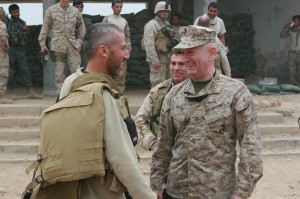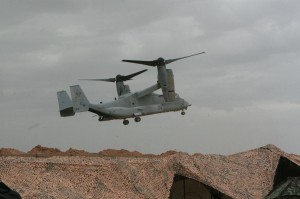Downrange: An Informal Report on a trip to Afghanistan with Marine General James N. Mattis

[Part Three of Four]
It’s more than a little weird, participating in one of these PR walkarounds. Self-congratulation is the inevitable theme. The bubble can get pretty thick. For me, at least, it’s almost impossible to grok the street reality. Are things going great or are we all lining up to drink our own Kool-Aid? For all I can tell, the sullen, hood-eyed bandits eyeballing our procession have been cutting loose AK rounds at Marines twenty-four hours earlier—and may be doing it again three days from now. Not that that means anything. Earlier in the trip, Gen. Mattis, speaking of Iraq and the Anbar Awakening, had credited British general Graeme Lamb with the philosophical breakthrough that made that turnaround embraceable by the field commanders, the battlespace owners. “Gen. Lamb’s mental model divided the Iraqi population into two groups—those who were reconcilable and those who weren’t. The trick was to reintegrate the first group into the life of the nation–and to kill or chase the second bunch out of Dodge.”

Gen. Mattis with an Afghan commando in Marjah, 28 Feb 2010
That would be the next phase here in Marjah and in the succeeding towns and cities on the Marines’ clear-hold-build list. Will it work? Can the ANA pull it off? Can the police from the new “government in a box?” Two days earlier we’d been in a meeting in Kabul with LtGen. William Caldwell, commander of the NATO Training Mission, and his staff, who had been tasked with bringing the ANA and ANP up to speed. I didn’t envy these officers; they had definitely drawn the fuzzy end of the lollipop.
Here’s how good intentions go wrong: the Pentagon has decreed that the job of training the Afghan National Police be outsourced. Contractors will do it. So the bids go out; one company wins. But wait, a spurned bidder files a protest. “Now we’re set back,” says Gen. Caldwell, “for however long it takes to settle the dispute. Meanwhile the individual contractors—retired American law enforcement officers, police chiefs and so forth—can’t stick around waiting half a year. They’ve taken other jobs.” Gen. Caldwell’s original wish list calls for over 2000 trainers; now he’s down to 400+, and it’s no sure thing that he’ll get even those. “And this,” notes on staffer, meaning the train-up of the ANP, “is the centerpiece of the whole counterinsurgency operation!”
The Machine giveth and the Machine taketh away.
9. Lashkar Gah is our next stop. The name means “camp of the warriors.” Alexander the Great’s warriors. His columns came through here in 330 B.C., skirting the Dasht-e-Margo, the Desert of Death, before setting up the tent city that would become Kandahar and trekking north across the Hindu Kush into the Bactrian plain. I peer down from our vertical-take-off Osprey. You can’t tell me much has changed in 2300 years. Below are mud-walled compounds, irrigated fields divided into squares, dark-eyed men in shalwar kameezes. The tribes even have the same names. Alexander and his generals sat around planning tables just like our ISAF commanders, trying to dope this theater out. The great conqueror employed the same tactics we’re using—he hired his enemies for pay, treated them with respect and sought to make them friends. He invested fortunes, built towns and cities, cut off cross-border sanctuaries (or tried to) and ran operations constituted of assault forces and blocking elements, aiming to trap the foe in between. I’m talking to a Marine colonel. “Alexander’s mother Olympias wrote him a letter once,” the officer tells me, “getting on his case for taking so long to knock off these primitive, poverty-stricken Afghans. So Alexander captured three tribal chiefs and sent them back to Macedonia, each one carrying an offering of soil from his own tribal homeland; they were supposed to deliver these tokens to Olympias as a gift from her son. But waiting outside the queen’s palace door, the three chiefs got into a fight and killed one another. Alexander’s Mom wrote back: ‘Now I understand, my son.’” I’m not sure what that story means in the current context, but I’m pondering it as we fly back to Kabul at dark.

Alexander would recognize some of the residents of Marjah
A Marine KC-130 is a cavernous, workhorse cargo plane powered by four turbo-props. You board via a rear ramp. The interior can be configured to ferry troops, in canvas seats facing inboard along the airframe wall with others facing outboard down the centerline, or for cargo on roller pallets. For this flight it’s fifty-fifty. Our nine-man troupe is joined by a platoon of Afghan commandoes, fresh out of the fight at Marjah. What a fine-looking bunch they are. The commandoes, Maj. Raymond of Gen. Mattis’ staff explains to me, are the cream of the ANA, way beyond the regular line troops. These guys are all young, no one above 22 is my guess. They look like fighters. Obviously this is their first plane ride. They’re trying to be cool, but as the huge, clamorous KC-130 starts rattling and banging into takeoff, all palms are turned heavenward in a quick prayer. Maj. Raymond shakes hands with a half a dozen of these young men; they light up with big, Chiclet smiles. The Taliban, a number of Marines have told me, haven’t stood up to our guys yet. Is the momentum shifting to the Coalition side? The enemy will mount a spring offensive, says Gen. Scaparotti of the 82nd Airborne. “He has to, because our side is getting so much traction. If the enemy lets us keep doing what we’re doing now, we’ll hit a tipping point and it’ll be over for him.”
10. Could this be true? Here, for what it’s worth, is how I see it after my trip inside the bubble:
The campaign has two extremities. At the top-end is the NATO/ISAF/American Machine. This Machine is made up of men and money, of massive bases and O’Hare-sized airfields, of vehicle parks and tarmac aprons chockablock with MRAPs and Black Hawks and C-130s and Navy fighters. Its elements include drones and laser-guided missiles, satellite imaging and biometrics. It is thousands of tons of supplies and construction materials; rooms full of captains and majors manning laptops; it is PowerPoints, flow charts and projections, focus groups, think tank treatises. The Machine is also constituted of a can-do attitude, a fierce and dedicated work ethic, a commitment to integrity and transparency and an attitude of good intentions that no one who has seen it can ever doubt. All of it is powered by a will and a level of professionalism that is without peer for putting a man on the moon or a thousand-pound bomb down a chimney. That’s the input end of the dynamic. That’s the Machine.
At the bottom, at the receiving end, is the villager, the tribesman and the Afghan man in the street. From where he stands, the Machine is a marvel. It is rich beyond imagining. It can call down death from the sky or beyond the horizon; it can see in the dark and strike without warning out of nowhere. Its intentions are good. Its heart is in the right place. But what can it do for him? He has seen clever men manipulate the machine and wicked men take vengeance on those who have been reckless enough to befriend it. He may be illiterate, this man of the village or the street, but he is not stupid. He has seen great powers come and go. In his own or his father’s lifetime he has lived through domination by the Soviets, the Afghan communists, the warlords and the Taliban. Now the NATO Machine has come. If our man can tap this apparatus for a job or a contract, he will. Every little bit helps. Most Afghans, we are told, view the Coalition presence favorably. I would too. The Yanks and their allies bring in cash and development projects, and they’re a far more benign presence that Genghis Khan or the Brits or the Russians, who were there for reasons of conquest or self-aggrandizement. The Americans just want to help. The Machine wants to bring security, development, education. It wants to get Afghanistan up on its feet. Can it?

An Osprey comes in over Marjah. Note the .50-caliber machine gun aft. In foreground, beneath camo netting, are the tents where the Marines have temporarily set up camp.
In the middle lies the space between the Machine and the man of the village, the man of the tribes. Here is the payoff point. This ground is occupied by the Marines and Army troopers and allies who man the frontier posts in the mountains, who hold down the outposts in the south and east. This space is held by the Marines in Helmand who fight and camp with their Afghan counterparts, who wash in the canals and eat the same lentils and flatbread, who haven’t had a shower in the past twenty-one days and won’t have one for the next three months. These are the guys who put a human face on the Coalition effort. They’re the young warriors who make friends and learn the lingo and constitute the person-to-person payload that the Machine above (which is as remote to them as it is to the Afghans they operate beside) has come halfway around the world to deliver.
My question is: are there enough of them? Have they penetrated deeply enough? Will they stick around? Does the Coalition possess the patience and political will to give their efforts time to bear fruit?
[Photos by 1LT Joshua Diddams, MEB-A Media Officer.]




great writing and information, and spot on from what my friends have told me.
No more Tomcats, if you are talking fixed wing aircraft. I do appreciate the report.
Thanks for the great blog and being such a patriot. I do think your 5% of those serving is a little high. According to the book you sent by Jack Jacobs, which was great, he states that only 1.5%of the American population serve in the military…..and then think what that number is if it takes 9 people in the rear to support every trooper in combat.Keep up the great work…and I thought you were just a golf writer !!!!!! love ya LT
Cooler Post, der Blog ist wirklich auch sehr informativ. Werde in Zukunft wieder mal vorbeikommen.
Sick of obtaining low numbers of useless traffic for your website? Well i wish to tell you about a fresh underground tactic that produces me personally $900 each day on 100% AUTOPILOT. I possibly could be here all day and going into detail but why dont you just check their site out? There is really a great video that explains everything. So if your serious about producing quick cash this is the site for you. Auto Traffic Avalanche